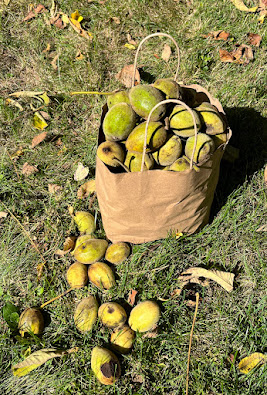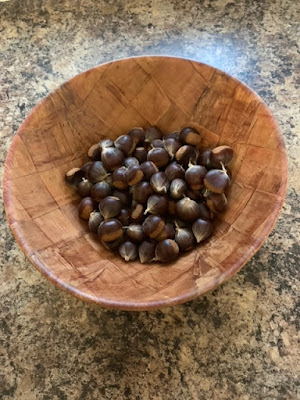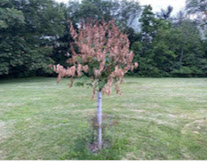There's a lot of gratitude being expressed towards trees these days. The gratitude tends to be towards trees in general, but this fall, I'm especially grateful for three trees in particular.
News from the preserves, parks and backyards of Princeton, NJ. The website aims to acquaint Princetonians with our shared natural heritage and the benefits of restoring native diversity and beauty to the many preserved lands in and around Princeton.
Friday, October 27, 2023
Update on Native Butternuts and Chestnuts in Princeton
Tuesday, July 11, 2023
Harrison Street Park: Contrasting Tales of Trees and Wildflowers
Friday, May 19, 2023
Some Flowering Trees and Shrubs in Mid-May
and pagoda dogwood
pawpaw hanging promisingly
Tuesday, May 02, 2023
Wisteria Contained
Monday, March 27, 2023
Wisteria's Tamed and Wild Twinings
The front porch of Morven has an educational feature for gardeners.
Go to the right side of the porch and witness Chinese wisteria twining up and to the right.Go to the left end of the porch and witness Japanese wisteria twining up and to the left.
Friday, October 21, 2022
The Emerald Ash Borer Quietly Changes Princeton's Skyline
clear fallen Ash trees from the Red Trail. It’s really heartbreaking."
In this section of trunk, where the bark has fallen away, you can see how the Emerald Ash Borer larvae consume the tree's cambium. Like the earth's total dependence on a thin surrounding layer of atmosphere (which of course our machines' invisible emissions are radically altering), a tree's vascular system depends on a thin layer of tissue surrounding the trunk, just below the bark. Lacking any evolved defense against the introduced ash borers, the native ash trees quickly become girdled and die.
I would speculate that, once the native and introduced parasitic wasps become widespread, they in combination with woodpeckers could allow ash trees to persist in Princeton, though perhaps few would grow to maturity unless regularly treated with systemic pesticide.Carolyn Edelman, a poet and nature enthusiast, recently posted a quote of Adlai Stevenson, II, dating back to a speech he gave in 1952. Its sentiment is part of a vein of American thought that views love of the American landscape as deeply connected to the love of freedom. For me, it is not coincidence that we live in a time when both nature and democracy are being undermined. Read the quote through today's filter of gender equality and inclusion to find its relevance.
It was always accounted a virtue in a man to love his country. With us it is now something more than a virtue. It is a necessity. When an American says that he loves his country, he means not only that he loves the New England hills, the prairies glistening in the sun, the wide and rising plains, the great mountains, and the sea. He means that he loves an inner air, an inner light in which freedom lives and in which a man can draw the breath of self-respect. Men who have offered their lives for their country know that patriotism is not the fear of something; it is the love of something.A great tree species passes from the landscape, but the love remains, and in that love reside both grief and possibilities.
Wednesday, October 19, 2022
The Wet Meadows Project Turns 25
A favorite prairie grass is little bluestem. It's always seemed like fall colors of prairie grasses are more vivid in the midwest. Perhaps a colder climate plays a role? The most brilliant example is Indian grass, whose bright orange and yellow mimic the flames that sometimes consume it.
Milkweed, anyone? Common milkweed spreads underground. A mildfire clears away the dead stems without harming the roots.
Dead stems can be as beautiful as the flowers. New England aster, wild bergamot, and the red leaves of blackberry mix with Indian grass.
After planting many wet meadows, the Wet Meadow Project began creating a food forest, to the right in this photo, with trees bearing apples, cherries and pawpaws, a grape arbor, raspberries, and many other edibles.
The local wildlife has a casual presence. What appeared to be a large green ant was crossing the asphalt path that winds through the park. It turns out to be variously named an oil beetle or blister beetle, Meloe campanicollis, though I must not have disturbed it enough to prompt it to secrete the oil that could blister my skin.
Thursday, December 30, 2021
Native Chestnuts in Princeton--the Next Generation
Many of us have lived our whole lives without seeing a mature native American chestnut tree. An excellent NY Times Magazine article described it as a true gift of nature, the perfect tree, growing straight and tall, with rot-resistant wood, and bearing nuts that were easily gathered and eaten, sustaining wildlife and people alike. My first encounter with the American chestnut was the sight of their fallen trunks in a Massachusetts forest, 70 years after the fungus that causes chestnut blight was discovered in NY city in 1904. The massive trunks I saw, lying on a slope in the shade of young white pine, were among the billions that the accidentally imported fungus would ultimately kill in the U.S. Since the roots survive the fungus, there was still a living community of underground chestnut trees beneath our feet in that Massachusetts forest. One of the roots had sent up a sprout about twenty feet tall--promising, one would like to think, but its slim trunk was already ringed by the fungus, its fate sealed before it could bear nuts.
One of the projects I'm involved in is reintroducing native chestnuts to Princeton. The initiative began in 2009 with an email from Bill Sachs, a Princetonian with considerable expertise when it comes to nut-bearing trees. Bill reported that Sandra Anagnostakis, "one of (if not the) world’s leading experts on the pathology of American chestnut," had agreed to supply us with disease-resistant, hybrid American chestnut trees. Sandra's efforts to breed resistant native chestnuts at the Connecticut Agricultural Experiment Station over many decades was apparently unconnected to the American Chestnut Foundation. The trees were 15/16th native, and Bill with occasional help from me and others proceeded to plant them at the Princeton Battlefield, Harrison Street Park, the Textile Research Institute, Mountain Lakes and Herrontown Woods.
Some fared better than others. Many, despite having been bred for resistance, nonetheless struggled with the blight that had laid the mighty tree low a century ago. This fall, however, paralleling our work to bring back native butternuts, one of the chestnut trees has borne fertile seeds.
Bill made repeat visits to the tree to collect the nuts as they ripened. The deer likely got many, but he managed to gather quite a few, some of which he encouraged me to cold stratify. Stratification has always been an intimidating concept for me, suggesting sophisticated manipulation to get a seed to germinate, but in this case it turned out to be not much more than stuffing some seeds in a bag of moist peat moss and leaving it in the back of the refrigerator for awhile.Wednesday, June 09, 2021
Chance Encounters with Trees in Lambertville and New Hope
My awareness of trees made me a mixed bag as a companion on a recent visit to Lambertville. The same eye that spots nature's wonders makes it hard to ignore tragedy.
Most mulberry trees grow straight up, leaving the abundant berries frustratingly out of reach, but this one grows right out of the old stone wall of the canal. Suspended above the water, its limbs grow horizontally towards the sidewalk, making for a beautiful presentation of berries to passersby.
Saturday, May 15, 2021
Native Azaleas Bloom Again at Herrontown Woods
Thursday, March 25, 2021
Some Unusual Trees
Here are some encounters with unusual trees in Princeton.
In the Institute Woods, we saw a couple beech trees some distance from a trail and took a closer look. Not quite the California redwood that people could once drive a car through, but similar in concept.Another beech nearby was harder to pose with.
by an Irish clover.
Here's an odd sighting. It looks like an ordinary stump, but the tree was clearly cut down and removed. The forest is quite old, so the logging must have been long ago. My guess is that it's the stump of a chestnut tree harvested a century ago. One of the many wonderful traits of the native chestnut, lost to an introduced disease a century ago, was its resistance to decay. Working briefly for a forester in Massachusetts in the 1970s, I saw whole logs of fallen chestnuts still intact despite the passage of many decades. I'm ready to be wrong on this ID, but that's what I'm going with for now.























































